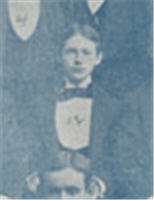-
Handy checklist to determine whether a work is in the public domain in the US.
-
Nicely executed. Missing only a few details (astronaut dummy with donut) to join the police cruiser atop the Great Dome as one of the great all-time hacks.
Day: May 18, 2009
Virginia Glee Club history: Harrison Randolph
 Exploring some of Google’s new search options a week ago bore surprising fruit, as I discovered enough about the first named conductor of the Virginia Glee Club, Harrison Randolph, to write a Wikipedia article about him. There has long been little publicly available information about Randolph, aside from a mention in Philip Bruce’s 1921 five volume history of the University of Virginia and his presence in the archival 1893 Glee Club photo that also features the author of the “Good Old Song.” The liner notes to the Club’s 1972 recording A Shadow’s on the Sundial place him as the organist at the University Chapel, but otherwise he seemed doomed to fade into obscurity.
Exploring some of Google’s new search options a week ago bore surprising fruit, as I discovered enough about the first named conductor of the Virginia Glee Club, Harrison Randolph, to write a Wikipedia article about him. There has long been little publicly available information about Randolph, aside from a mention in Philip Bruce’s 1921 five volume history of the University of Virginia and his presence in the archival 1893 Glee Club photo that also features the author of the “Good Old Song.” The liner notes to the Club’s 1972 recording A Shadow’s on the Sundial place him as the organist at the University Chapel, but otherwise he seemed doomed to fade into obscurity.
However, when I did a news timeline search for “virginia glee club”, I turned up some hits in the 1890s that I hadn’t seen before. In particular, one 1894 report in the Atlanta Constitution gave me quite a bit more information about Randolph and the boys of the Glee Club than I had seen previously. In this case, the description of Randolph as an “instructor of mathematics” made me go back and look deeper into his biography, and I turned up a fuller biography of him in a 1920-era volume that says that he left Virginia in 1895 to go to the University of Arkansas, and then in 1897 to the presidency of the College of Charleston, where he spent nearly the next 50 years.
It appears, despite his accomplishments, that the directorship of the Glee Club was not then without its perils; the Constitution gives a glowing description of his intellect, then drily notes, “To him has been allotted the awful task of directing the Glee Club.” Even allowing for the “amazing,” “awe-inspiring” sense of the word, one still feels the pressure of the world on Randolph’s young shoulders, particularly looking back at his 1893 photograph. Born the same year as the Glee Club itself, he looks at the age of 22 smaller and more exhausted than those around him in the publicity photo. Is it any wonder that only two short years later he fled to the relatively safer world of academia?
For those with patience, I’ve added the text of the original 1894 concert review article; it provides a rare glimpse at the mechanics of how the Glee, Banjo, and Mandolin clubs worked together and gives thumbnail biographies of each member.
